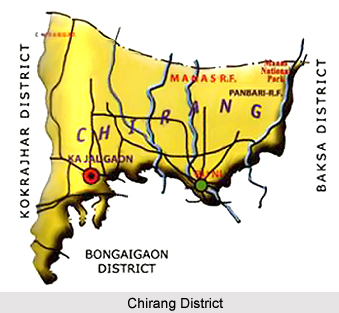 Chirang is relatively a new district of Assam. It has been carved out from Bongaigaon District, Kokrajhar, Bongaigaon and Barpeta districts in 2004. Kajalgaon is the district headquarters. The two Sub-Divisions in the district: Kajalgaon Sadar Sub-Division and Bijni Civil Sub-Division.
Chirang is relatively a new district of Assam. It has been carved out from Bongaigaon District, Kokrajhar, Bongaigaon and Barpeta districts in 2004. Kajalgaon is the district headquarters. The two Sub-Divisions in the district: Kajalgaon Sadar Sub-Division and Bijni Civil Sub-Division.
History of Chirang District
Chirang District is the new district in the BTC area of the state. Chirang district has been carved out from Bongaigaon district in the year 2004. The word "Chirang" has derived from Garo word -"Chi" means Water and "Rang" means wealth
.
Geography of Chirang District
The Chirang district possesses a plain topography. It also has undulating areas and the northern parts of the district lie on the foothills of Bhutan that has slightly higher elevation, which is decreasing towards the southern parts of the district. The four types of soil found here are Entisols, Inceptisols, Alfisols and Ultisols. The district comes under Lower Brahmaputra Valley Agro-Climatic Zone. The climate is sub-tropical in nature with warm and humid summer followed by dry and cool winter. The pre and post-monsoon months are unpredictable and experience erratic rainfall. Champamati, Aie and Manas rivers flow through the district and join the Brahmaputra River. Many other tributaries, small rivulets and streams flow through this district.
Demography of Chirang District
According to the Population Census in 2011, the Chirang District had population of 481,818 of which male and female were 244,675 and 237,143 respectively. The population of Chirang District constituted 1.55 percent of total population of Assam. The population density of Chirang district is 244 people per sq. km. The average literacy rate of Chirang District was 64.71 %. If things are looked out at gender wise, male and female literacy were 71.35 % and 57.87 % respectively. The total literates in Chirang District were 266,380 of which male and female were 149,017 and 117,363 respectively.
Tourism in Chirang District
The following are the Tourist spots: Bongaigaon Refinery (IOCL), Champamati Mini Hydro-Electric Power Project, Kalamati(Orchid and Butterfly habitat), Ghumeswar Hills, Tukrabasti( picnic spot), Gabharukhunda(Biological Hotspot), Manas Tiger Reserve and Raja Charang Mandir in Basugaon.






